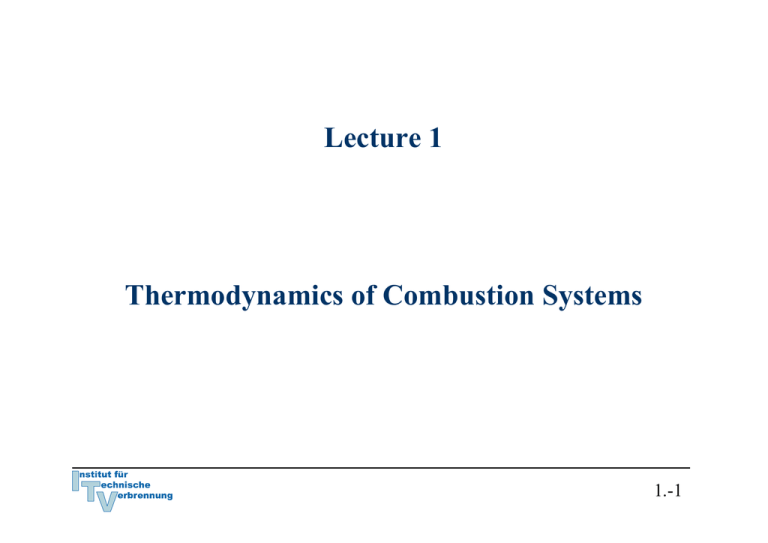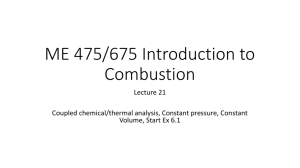Lecture 1 Thermodynamics of Combustion Systems
advertisement

Lecture 1 Thermodynamics of Combustion Systems 1.-1 Combustion - mass and energy conversion process - chemical bond energy → thermal energy Fuel reacts with the oxygen of the air → products (mainly carbon dioxide and water) with lower enthalpy of formation or reference enthalpy than the reactants 1.-2 The final state of a homogeneous system is governed by the classical balance laws of thermodynamics. Prerequisites: - definitions of concentrations and thermodynamic variables - mass and energy balance for multicomponent systems 1.-3 Mole Fractions and Mass Fractions In chemical reactions chemical elements are conserved. For example: the particular atom defining the element C within a CH4 molecule will be found within the CO2 molecule if combustion is completed. In order to describe the chemical transformation between species quantitatively, we need to introduce definitions for concentrations. 1.-4 The Mole Fraction Multi-component system with k different chemical species Mole: 6.0236 1023 molecules are defined as one mole. Number of moles of species i: ni Total number of moles: Mole fraction of species i: 1.-5 The Mass Fraction Mass mi of all molecules of species i is related to its number of moles by where Wi is the molecular weight of species i. Total mass of all molecules in the mixture: Mass fraction of species i: Mean molecular weight W 1.-6 The mass fraction of elements The mass fraction of elements is very useful in combustion. Mass of the species changes due to chemical reactions, the mass of the elements is conserved. Mass and molecular weight of all atoms of element j contained in all molecules: mj , Wj Number of atoms of element j in a molecule of species i : aij Mass of all atoms j in the system: where ke is the total number of elements in the system. Notice that no meaningful definition for the mole fraction of elements can be given because only the mass of the elements is conserved. 1.-7 The mass fraction of element j is then From the definitions above it follows 1.-8 The partial molar density Number of moles per volume V or partial molar density, the concentration: The molar density of the system is then 1.-9 The Partial Density The density and the partial density are defined The partial molar density is related to the partial density and the mass fraction by 1.-10 The thermal equation of state In most combustion systems of technical interest the law of ideal gases is valid. Even for high pressure combustion this is a sufficiently accurate approximation because the temperatures are typically also very high. In a mixture of ideal gases the molecules of species i exert on the surrounding walls of the vessel the partial pressure Universal gas constant equal to 1.-11 Dalton's law For an ideal gas the total pressure is equal to the sum of the partial pressures. Thermal equation of state for a mixture of ideal gases The partial pressure is equal to the total pressure times the mole fraction Defining the partial volume by it follows that an equivalent relation exists for the partial volume 1.-12 Stoichiometry Equations describing chemical reactions Global reactions like or elementary reactions like are based on the principle of element conservation during reaction. The stoichiometric coefficients of the reactant i: The stoichiometric coefficients of the product i: 1.-13 If Mi stands for the chemical symbol of species i a reaction equation may be cast into the form Net stoichiometric coefficient is positive for products and negative for reactants. A system of r elementary reactions may be written where the net stoichiometric coefficient of species i in reaction l is: 1.-14 The stoichiometry defined by the reaction equation relates the molar production or consumption of species to each other. The change of the number of moles of species i to that of species 1 is The relation between the partial masses is Since the total mass in the system is independent of the chemical reaction (while the total number of moles is not), the relation between mass fractions is 1.-15 A fuel-air mixture is called stoichiometric, if the fuel-to-oxygen ratio is such that both are entirely consumed when combustion to CO2 and H2O is completed. For example, the global reaction describing the combustion of a single component hydrocarbon fuel CmHn (subscript F for fuel) the stoichiometric coefficients are where may be chosen arbitrarily to unity. 1.-16 Stoichiometric mixture requires that the ratio of the number of moles of fuel and oxidizer in the unburnt mixture is equal to the ratio of the stoichiometric coefficients or in terms of mass fractions where ν is called the stoichiometric mass ratio. Then fuel and oxidizer are both consumed when combustion is completed. 1.-17 Integrating with i = O2, 1 = F between the initial unburnt state (subscript u) and any later state leads to This may be written as 1.-18 For a stoichiometric mixture fuel and oxygen are completely consumed at the end of combustion: Introducing this into we recover 1.-19 The Mixture Fraction The mixture fraction is an extremely useful variable in combustion in particular for diffusion flames. Here we present it first for a homogeneous system. In a two-feed system a fuel stream (subscript 1) with mass flux m1 is mixed with an oxidizer stream (subscript 2) with mass flux m2. The mixture fraction represents the mass fraction of the fuel stream in the mixture: Both fuel and oxidizer streams may contain inerts such as nitrogen. 1.-20 The mass fraction YF,u of the fuel in the mixture is proportional to the mass fraction in the original fuel stream, so where YF,1 denotes the mass fraction of fuel in the fuel stream. Similarly, since 1-Z represents the mass fraction of the oxidizer stream in the mixture, one obtains for the mass fraction of oxygen in the mixture where YO2,2 represents the mass fraction of oxygen in the oxidizer stream (YO2,2 = 0.232 for air). 1.-21 Introducing and into one obtains the mixture fraction as a variable that couples the mass fractions of the fuel and the oxygen For a stoichiometric mixture one obtains with the stoichiometric mixture fraction 1.-22 Profiles of YF and YO2 in the unburnt gas 1.-23 If Z < Zst fuel is deficient and the mixture is called fuel lean. Then, combustion terminates when all the fuel is consumed: (burnt gas, subscript b). The remaining oxygen mass fraction in the burnt gas is calculated from as where was used. 1.-24 Similarly, if Z > Zst oxygen is deficient and the mixture is called fuel rich. Combustion then terminates when all the oxygen is consumed: Leading to For the hydrocarbon fuel considered above the element mass fractions in the unburnt mixture are or 1.-25 For a stoichiometric mixture where it follows that the combination vanishes. 1.-26 Normalizing this such that Z = 1 in the fuel stream and Z = 0 in the oxidizer stream, one obtains Bilger's definition or Because elements are conserved during combustion, the element mass fractions calculated from do not change. 1.-27 For the burnt gas they are for the hydrocarbon fuel considered above 1.-28 This leads with and and for for to piecewise linear relations of the product mass fractions in terms of Z: where 1.-29 Profiles in the burning mixture 1.-30 The fuel-air equivalence ratio is the ratio of fuel-air ratio in the unburnt to that of a stoichiometric mixture Introducing and into leads with to a unique relation between the equivalence ratio and the mixture fraction 1.-31 This relation is also valid for multicomponent fuels (Exercise). It illustrates that the mixture fraction is simply another expression for the local equivalence ratio. Exercise: The element mass fractions of a mixture of hydrocarbons and its mean molecular weight W are assumed to be known. Determine its stoichiometric mixture fraction in air. A hint: 1.-32

